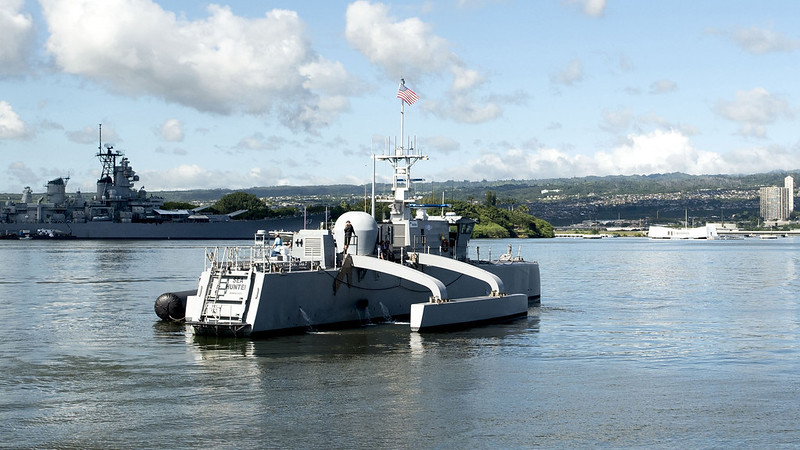
In the next 15 years, the development of unmanned systems in the air, on and under the waves and on land, alongside sophisticated networks of ‘sensors and shooters’, is likely to accelerate. Australia must be ready to respond. In a speech at the recent 2019 Sea Power conference in Sydney, Minister for Defence Linda Reynolds argued that:
The challenge for Navy, for Defence and for the nation, is how to remain flexible enough in defence acquisition to augment major platforms using new and emerging technologies to secure both our offensive and defensive advantages … Unmanned underwater, air and surface vehicles assisted by artificial intelligence are other rapidly emerging areas of technology that will change traditional ways of thinking about naval warfare and sea control.
At the moment, especially in relation to unmanned systems, the Royal Australian Navy’s mindset isn’t likely to meet the challenge identified by the minister. The large platforms that will come into operational service after a long acquisition cycle are in danger of being rendered impotent in the face of swift changes in new technologies, including unmanned autonomous systems.
The navy is currently focusing on small, tube-launched unmanned underwater vehicles that can undertake basic mine-clearance tasks or surveillance. But that emphasis may prove to be misplaced if such systems are overtaken by much more capable platforms that can operate entirely independently from manned submarines.
Fully autonomous unmanned underwater and surface vehicles with global range, extended time on station, and sophisticated sensor and weapons capabilities are likely by the mid-2030s, at relatively low cost and without the personnel challenges that manned naval vessels bring.
Both the US and UK navies are looking to acquire extra-large UUVs. The US Navy reportedly has a contract with Boeing for five Orca XLUUVs at a total cost of $300 million and an entry into service by 2022. It has sailed its Sea Hunter unmanned surface vehicle across the Pacific, in what may be the beginning of a transformation into a mixed manned–unmanned fleet.
If it followed the US and UK examples, by 2035 the RAN could introduce a fleet of 24 XLUUVs for about $1.5 billion, plus operating costs and the cost of building robust command-and-control networks. That’s about a quarter of the cost of a single Attack-class boat. That sounds a very attractive proposition for expanding the navy’s combat mass through unmanned systems at a lower cost compared with additional crewed platforms.
This is not a call to scrap the Attack-class submarine or abandon the Hunter-class frigate. It is a call to strengthen our emphasis on building manned–unmanned teaming at sea. We also need to consider the role of unmanned systems, not just as a niche capability akin to a small recoverable torpedo, but as an entirely new class of primary military capability for the Australian Defence Force.
Australia should be considering how unmanned systems, on and under the waves—operating entirely independently from manned platforms when necessary, but as part of a teaming approach when possible—can be incorporated into the ADF’s future force structure. We should aim to have a mix of manned and unmanned platforms at sea, in the air and on land, including sophisticated long-range, long-endurance and armed autonomous platforms.
Above all, we need to be boldly imaginative. Constraining our thinking to tube-launched UUVs on the Attack submarines is neither bold nor imaginative. Once we cast aside orthodox mindsets and ask more forward-looking questions, innovative thinking can be more easily take hold.
How might our fleet of Attack-class subs work with a platform similar to the Orca XLUUV or Sea Hunter USV in future war? Could we use such unmanned systems to control key maritime straits to prevent a major-power adversary from projecting naval forces into our maritime approaches, or to act as forward sensors for our shooters, resident on our naval surface combatants?
In an era of advanced supersonic anti-ship missiles, anti-ship ballistic missiles and hypersonic glide vehicles, deploying crewed naval surface combatants such as the Hobart-class air warfare destroyers or Hunter-class frigates in heavily contested environments such as the South China Sea could be disastrous. It’s better to rely on large, long-range unmanned systems that could give the ADF the ability to go into harm’s way without risking heavy loss of life.
Unmanned autonomous systems have enormous growth potential that if fully developed could remake the navy. One debate on capability that keeps re-emerging is whether Australia needs fixed-wing naval airpower and, if so, whether we should acquire a squadron of STOVL (short take-off and vertical landing) F-35B joint strike fighters to provide that capability, perhaps operating from an adapted Canberra-class landing helicopter dock ship.
If we’re thinking about how best to incorporate unmanned systems into the ADF in a more holistic way, rather than F-35Bs on a converted LHD offering only a 70% solution, it may be better to locally design and construct a purpose-built vessel to support an entirely unmanned air wing.
This could comprise fixed or rotary-wing UAVs such as the Northrop Grumman Firescout or the US DARPA’s Tern, for naval intelligence, surveillance and reconnaissance, as well as fixed-wing armed UCAVs to conduct strikes and to support naval air defence at long range. The latter could, for example, be based on a navalised variant of the Boeing Australia ‘airpower teaming system’ loyal wingman concept.
The minister set a challenge for Australian defence industry, stating that:
Industry must do its part—from research and development, to construction; from through-life support to disposal. We need construction infrastructure to deliver the projects; and the workforce to do everything from designing and building ships and submarines, to integrating combat systems and managing the complexity of major programs.
Developing a vessel designed for fixed-wing naval aviation capability, based on emerging unmanned autonomous systems, would enable Australia’s defence industry to contribute directly to meeting the challenge posed by the minister. Navy and Defence should be bold enough to make that happen.

